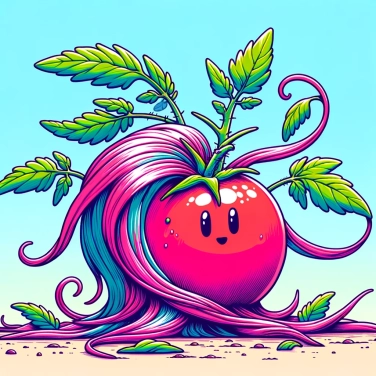In detail, for those interested!
The trichomes of tomato plants.
The trichomes of tomato plants are small hairs present on the leaves, stems and sometimes even on the fruits. These unicellular structures can vary in shape, size and density depending on the tomato varieties. Trichomes can be glandular, meaning they secrete substances, or non-glandular.
Non-glandular trichomes are usually simple and straight, while glandular trichomes can be branched and swollen at the tip. The glands secrete a variety of chemical compounds, such as essential oils, fatty acids and phenolic compounds, which can play an important role in protecting the plant against harmful insects, diseases and UV rays.
Glandular trichomes can also produce compounds responsible for the characteristic aroma and flavor of tomatoes. These volatile substances help defend the plant against herbivores and can attract natural predators to combat pests.
In addition to their defense functions, the trichomes of tomato plants can also help regulate transpiration by reducing water evaporation and creating a barrier against unfavorable environmental conditions. These small structures thus contribute to the health and survival of tomato plants in sometimes challenging environments.
The roles of trichomes
Trichomes play several essential roles in the life of tomato plants. First, these hair-like structures act as a physical barrier against harmful insects and predators. Their presence on the leaves makes it more difficult for insects to eat them or lay their eggs on them. Additionally, trichomes can secrete chemicals that repel these insects, acting as a form of chemical defense for the plant.
Furthermore, trichomes can also play a role in regulating the temperature of the leaves. Their hairy structure helps trap air around the leaf, creating a kind of microclimate that helps protect the plant from temperature and humidity fluctuations. This thermal regulation can be especially important for tomato plants growing in environments where temperatures can be extreme.
Lastly, trichomes can also help reduce water loss through transpiration by limiting air circulation around the leaves. This adaptation is crucial for tomato plants, which need to conserve water to survive in sometimes arid conditions. By reducing transpiration, trichomes help tomato plants save water and maintain their hydration, even in the presence of water stress.
The benefits of hairy leaves.
The hairy leaves of tomato plants offer several advantages. Firstly, the hairs on these leaves act as a physical barrier that deters insects and predators from approaching. These trichomes can also produce chemical compounds, such as sticky or toxic substances, which can repel attacks from harmful insects or deter them from feeding on the leaves.
Furthermore, hairy leaves help reduce water loss through evaporation. The hairs act as an insulating layer that limits the amount of water that evaporates from the plant, which is particularly advantageous in arid environments or during drought conditions. Additionally, trichomes reflect sunlight, helping to prevent leaf overheating and protect the plant from damage caused by excessive heat.
Finally, the hairs on hairy leaves can also play a role in defense against fungal diseases. By creating an additional layer around the leaf, trichomes can reduce moisture and mold formation, thereby limiting the risks of moisture-related diseases.
In summary, the hairy leaves of tomato plants provide natural protection against insects, predators, excessive water loss, overheating, and fungal diseases, giving these plants a significant adaptive advantage.
![Explain why some countries change time zones?]()
![Explain why Alexander the Great refused to wear shoes.]()
![Explain why Alexander the Great always wore an impressive helmet.]()
![Explain why the last Chinese emperor was so young when he came to power?]()





















